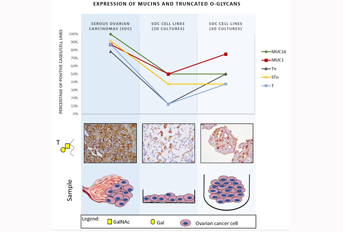Associação Portuguesa de Investigação em Cancro
Mucins and Truncated O-Glycans Unveil Phenotypic Discrepancies between Serous Ovarian Cancer Cell Lines and Primary Tumours
Mucins and Truncated O-Glycans Unveil Phenotypic Discrepancies between Serous Ovarian Cancer Cell Lines and Primary Tumours

Ricardo Coelho1,2,3, Lara Marcos-Silva1,2,4,5, Nuno Mendes1,2, Daniela Pereira1,2, Catarina Brito4,5, Francis Jacob6, Catharina Steentoft7, Ulla Mandel7, Henrik Clausen7, Leonor David1,2,3 and Sara Ricardo1,2,3
1 Instituto de Investigação e Inovação em Saúde (i3S), Universidade do Porto, Porto 4099-002, Portugal;
2 Institute of Molecular Pathology and Immunology of the University of Porto (IPATIMUP), Porto 4099-002, Portugal;
3 Faculty of Medicine, University of Porto, Porto 4099-002, Portugal;
4 Instituto de Biologia Experimental e Tecnológica (iBET), 2780-901 Oeiras, Portugal;
5 Instituto de Tecnologia Química e Biológica (ITQB) António Xavier, Universidade Nova de Lisboa, Oeiras 2780-157, Portugal;
6 Glyco-Oncology, Ovarian Cancer Research, Department of Biomedicine, University Hospital Basel and University of Basel, Basel 4031, Switzerland;
7 Copenhagen Center for Glycomics, Department of Odontology, Faculty of Health Sciences, University of Copenhagen, Copenhagen, Denmark.
Optimal research results rely on the selection of cellular models capable of recapitulating the characteristics of primary tumours from which they originate. The expression of mucins (MUC16 and MUC1) and truncated O-glycans (Tn, STn and T) represents a characteristic footprint of serous ovarian carcinomas (SOCs). Therefore, selecting ovarian cancer (OVCA) cell lines that reflect this phenotype is crucial to explore the putative biological role of these biomarkers in the SOC setting. Here, we investigated a panel of OVCA cell lines commonly used as SOC models, and tested whether, when cultured in 2D and 3D conditions, these recapitulate the mucin and O-glycan expression profiles of SOCs. We further explored the role of truncating the O-glycosylation capacity in OVCAR3 cells through knockout of the COSMC chaperone, using in vitro and in vivo assays. We found that the majority of OVCA cell lines of serous origin do not share the mucin and truncated O-glycan footprint of SOCs, although 3D cultures showed a higher resemblance. We also found that genetic truncation of the O-glycosylation capacity of OVCAR3 cells did not enhance oncogenic features either in vitro or in vivo. This study underscores the importance of well-characterized cellular models to study specific features of ovarian cancer.
Journal: International Journal of Molecular Sciences
http://www.mdpi.com/1422-0067/19/7/2045




